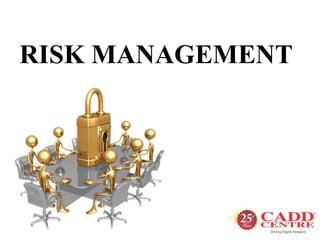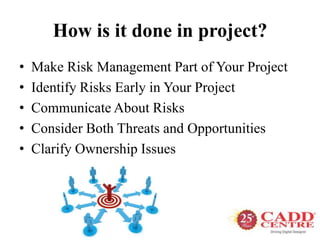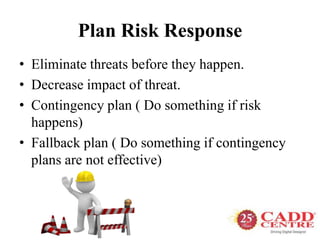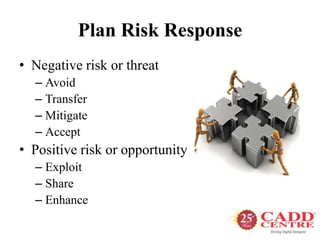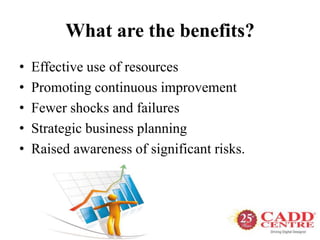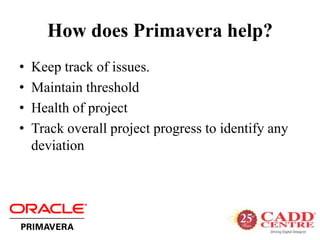Risk management
- 2. What is Risk Management? • Risk is an uncertain event that may have a positive or negative impact on the project. • Risk Management is the process of identifying and migrating risk.
- 3. Why is it important? • Risk affects all aspects of your project – your budget, your schedule, your scope, the agreed level of quality, and so on • Increase probability of positive event. • Reduce the occurrence of negative event.
- 4. What does it include? • Risk Management Planning • Risk Identification • Qualitative Risk Analysis • Quantitative Risk Analysis • Risk Response Planning • Risk Monitoring and Control
- 5. How is it done in project? • Make Risk Management Part of Your Project • Identify Risks Early in Your Project • Communicate About Risks • Consider Both Threats and Opportunities • Clarify Ownership Issues
- 6. How is it done in project? • Prioritise Risks • Analyse Risks • Plan and Implement Risk Responses • Register Project Risks • Track Risks and Associated Tasks
- 7. Risk in Project Management Plan Risk Management Quantitative Risk Analysis Identify Risk Plan Risk Response Qualitative Risk Analysis Monitor and Control Risk
- 8. Plan Risk Management • Analysis and decision making to implement risk management. • Appropriate to size and complexity of the project. • Stakeholders will be involved in planning risk management.
- 9. Risk Management Plan • Schedule Risk • Cost Risk • Quality Risk • Scope Risk • Resource Risk • Customer Satisfaction Risk
- 10. Identify Risk • Which risk has more probability of affecting the project? • SWOT Analysis • Information gathering • Check-list Analysis • Assumption Analysis
- 11. Qualitative Risk Analysis • Assess impact and likelihood of the identified risk. • Probability and Impact Matrix. • Risk categorization. • Risk urgency assessment.
- 12. Quantitative Risk Analysis • Data gathering – Direct – Diagrammatic – Delphi • Probability distribution • Modeling Techniques – Decision tree Analysis – Sensitivity Analysis – Expert Judgment
- 13. Plan Risk Response • Eliminate threats before they happen. • Decrease impact of threat. • Contingency plan ( Do something if risk happens) • Fallback plan ( Do something if contingency plans are not effective)
- 14. Plan Risk Response • Negative risk or threat – Avoid – Transfer – Mitigate – Accept • Positive risk or opportunity – Exploit – Share – Enhance
- 15. Monitor and Control Risk • Risk Reassessment (Scheduled regularly to identify new risk) • Risk Audit (Examine the effectiveness of planned risk response) • Trend analysis (Monitor overall project performance)
- 16. What are the benefits? • Effective use of resources • Promoting continuous improvement • Fewer shocks and failures • Strategic business planning • Raised awareness of significant risks.
- 17. What are the benefits? • Quick grasp of new opportunities • Enhancing communication • Reassuring stakeholders • Focus on internal audit programme • Recognition of responsibility and accountability.
- 18. How does Primavera help? • Keep track of issues. • Maintain threshold • Health of project • Track overall project progress to identify any deviation
- 19. Itaipu Dam
- 20. Thank You
